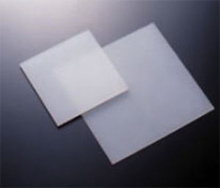Rexolite (Cross Linked Polystyrene)
Finish Plastics | High Performance Plastics

Rexolite is a thermoset, rigid and translucent plastic produced by cross linking polystyrene with divinylbenzene. The material is known for its unusually stable electrical properties into the Giga-hertz range. A cross-linked polystyrene copolymer which is rigid, transparent and colourless with outstanding electrical properties, including low dielectric losses up to very high frequencies, and very high radiation resistance. It has good dimensional stability, is easily machined and can be polished to a high optical quality. Compared to normal polystyrene, it is harder and somewhat more temperature resistant.
Rexolite is a rigid, transparent insulating material made by an irradiation cross-linking process. Rexolite is one of the best dielectric materials known with a dissipation factor 200 times better than nylon.
In contrast with other high temperature, ultrahigh frequency dielectrics, Rexolite has the rigidity and ability to resist deformation under load. These characteristics are extremely important where assembled insulators must withstand compression without yielding and loosening over long periods of time.
Rexolite materials are cast in liquid form and cured to make sheets, then ground to size, coated with a patented adhesive polymer and clad in a laminating press. Homogeneous and isotropic electrically as well as radiation resistant, they are available clad with electrodeposited or rolled copper on one or both sides.
Because it is cross linked polystyrene, rexolite has excellent machinability and shock resistance when compared to other unreinforced thermoset materials.
Rexolite is superior to most plastics. Little change in dielec-tric loss over a wide range of exposures up to 1000M rads. Rexolite has superior resis-tance to mechanical deterioration by ionizing radiation.
Characteristics
Outstanding Dielectric properties.
Dielectric constant of 2.53 (up to 500GHZ) together with extreme low dissipation factor.
Valuable for microwave lenses, microwave circuitry, antennae, coaxial cable connectors, sound transducers, TV satellite dishes and sonar lenses.
Other uses include non-destructive material testing devices, surveillance equipment, radar windows, radomes and missile guidance system housings. One interesting application is for radar lenses which are used for mapping the earth's surface from fast high-flying aircraft.
High voltage insulators.
Ability to withstand high voltage is important for producing gap switch houses, capacitors and other components. Rexolite is proven superior over acrylic for dendriting resistance.
Radiation Resistance
Superior to most plastics. Little change in dielectric loss over a wide range of exposures up to 1000M Rads. Has superior resistance to mechanical deterioration by ionizing radiation.
Rigidity and dimensional stability
Rexolite exhibits no permanent deformation or plastic flow under loads of 10 to 2000 PSI at temperatures of 20 to 125 C. In addition, all castings are stress-free, not requiring any stress relieving prior to, during or after machining.
Self extinguishing
Burn rate of less than 1' per minute.
Optical
Transmission approximately equals to acrylic - (87% visible light, 1' thick). Refraction index 1.59 @ 589 nanometers, 1.604 @ 486 nanometers and 1.585 @ 656 nanometers. Used in combination with acrylic lenses for color correction.
Sound transmitting
Excellent acoustic impedance close to water. Velocity 93x10'/second.
Out Gassing
Negligible. Residual monomer greatly reduced.
Water Absorption
Less than .05 percent. Type 1422 has been immersed in boiling water for 1000 hours without change in dielectric constant.
Machinability
Handles well in all machining operations. Tool configuration is similar to those used on acrylic. Because of high resistance to cold flow and freedom from stress, it is easily machined or laser beam cut to very close tolerances and accuracy of .0001 can be obtained in grinding. Rexolite will not craze, providing sharp tools are used and excessive heat is not generated in polishing.
Chemical resistance
Alkalies, alcohols, aliphatic hydrocarbons and mineral acids have no effect. Aromatic and hydrocarbons cause swelling and should be avoided.
Light weight
Specific gravity of 1.05. Approximately 15 percent lighter than acrylic and less than half of TFE.
Environmentally friendly
Non-hazardous, contains no ingredients harmful to the environment.
TYPICAL APPLICATIONS
Rexolite is often used for high-frequency circuit substrates, microwave components, and lenses with acoustic, optical and radio-frequency applications.It is used primarily as a dielectric material in a wide range of components together with lenses, observation windows, X-ray equipment and radiation detectors. Additional typical applications include antennae, coaxial cable connectors, TV satellite dishes, surveillance equipment and missile-guidance-system housings.
Grades
Rexolite 1422
Rexolite 1422 has good physical and excellent electrical properties, including low loss and stable dielectric constant. The product is well suited for use in microwave lenses and precision components. Rexolite 1422 meets the requirements of L-P-516A (Type E2), formerly MIL-P-77 (Type E-2). Unfilled Rexolite 1422 is chemically resistant, light weight, resists water absorption, and has negligible outgassing. Thermoset cross-linked styrene copolymer. Combination of good physical and excellent electrical properties including low loss and stable dielectric constant makes this material suitable for use in microwave lenses as well as for precision components.
Rexolite 2200
Rexolite 2200 is reinforced with glass to provide greater temperature stability and strength. It is ideal for missiles and other applications where extreme cold, high temperatures and mechanical stress are encountered. The product is used mainly for printed circuit boards. The glass reinforcement yields a product with an exceptional strength-to-weight ratio and increased tensile strength. . Rexolite 2200 is glass filled which produces greater dimensional stability and rigidity without the sacrifice of key physical characteristics. Thermoset cross-linked styrene copolymer with glass mat reinforcement to provide greater temperature stability and strength. Highly suited for missile and other applications where extreme cold, thermal shock and mechanical stress are encountered.Used principally for printed circuit boards.
Rexolite copper-clad
For use in electronic circuits, both Rexolite 1422 and 2200 may be ordered in sheet thicknesses to 1/4' with copper-clad surface in thicknesses ranging from 1/2-ounce to 2-ounce copper.
Rexolite (Cross Linked Polystyrene) Pictures
